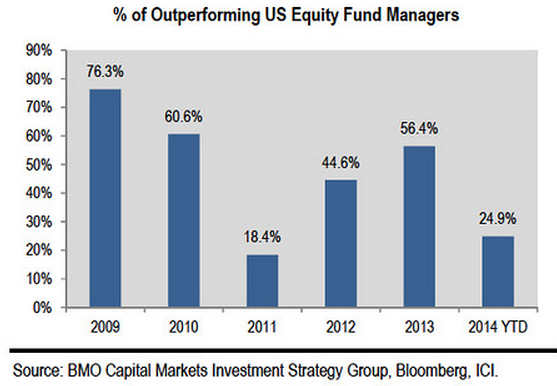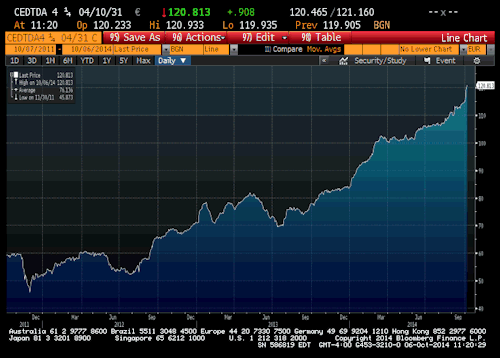Increasing volatility caused pain on short volatility plays in equity markets, hedge fund stops were hit as margin calls gave hedge funds a tougher ride down than going back up
It might seem odd that Societe Generale’s latest Hedge Fund report decries the lack of performance in hedge funds when a category it should be intimately familiar with, managed futures, continues to perform during crisis. The report titled ‘Hedge Funds Left Naked By Market Correction’ nonetheless provides significant insight into the current state of hedge fund positioning, if tilting slightly towards those equity-based hedge funds that have historically dominated Wall Street thought processes.
The report of hedge fund trade positions is always considered interesting as Newedge, Soc Gen’s derivatives brokerage holding, has access to many of the top algorithmic traders. It is odd, then, that at a time when the Newedge CTA Index is up by 0.10 percent month to date (as of October 23), the report indicates hedge funds are generally suffering during October.
Hedge funds exposed to the bond market correction
As a result of rising U.S. bond yields and long dollar trades, hedge funds were “exposed” to the correction. “Even diversification can be of little help, as trades in many different asset classes go south simultaneously, leaving one feeling rather, err, exposed,” the report quipped. What is one hedge fund’s exposure is another hedge fund’s opportunity.
There are several factors that the Soc Gen report says could lead to a hedge fund fail in October. This can be broken down into two basic categories that are most interesting: Hedge fund expectations of rising US bond yields (and related market trends, particularly in currencies) and volatility.
Hedge funds’ expectation for rising U.S. interest rates
The expectation for rising U.S. interest rates is in some cases viewed as a market crash hedge, a debt crisis play. At some point the math of government debt, the momentum of which appears can’t be stopped, overwhelms the ability of a sovereign nation to pay its debt obligations. At one point this thinking was considered “crazy,” but it was really crazy only to those who didn’t do the math. It is for this reason that certain hedge funds have a long interest rate play (and some have a general long volatility play) in their risk management plans.
While the interest rate hedge may have cost money in October – as the bet on higher interest rates met the gravity of stock market investors looking for safety in a falling stock market – that play continues to be a risk management concern. The report noted that short treasuries was already a crowded play, showing the popularity of the interest rate hedge, but “then rates fell again. Ouch!” says the report.
Hedge funds also got hit by rising volatility, the report said, noting that certain hedge fund VIX positions were required to be sold during the recent volatility spike. But perhaps the more specific issue certain hedge funds faced was their short option put positions on individual stocks. The report noted “hedge funds typically make money on short equity volatility positions.” In some cases, this is a strategy that can materialize in a short put long stock relative value trade, also commonly known as a “Texas hedge” in certain derivatives circles. When the stock market is rising the long equity position gains value while the short put position loses value. Since the investor is long the stock and short the put option, it’s a win win. Typically this strategy is used at a point when the investor is willing to go long additional stock. (See Netflix stock acquisition strategy from Mark Cubin for an example.)
Volatility causing traditional equity hedge funds difficulty
While Soc Gen noted volatility causing traditional equity hedge funds difficulty, it has benefited certain volatility hedge fund traders. The Typhon Proteus Dynamic Volatility hedge fund, under the supervision of derivatives executive James Koutoulas, is doing well in October. The volatility program, one of four programs Typhon manages, is up 2.49 percent on the month, outpacing the Newedge CTA index. Attain Portfolio Advisors Trend Fund is up 9.89 percent this month and Walter Gallwas, president and founding partner of the firm, notes the entire managed futures space has been doing well.
Soc Gen interestingly noted that many hedge fund traders were stopped out on their trades, the old “margin call,” and may suffered more to the downside than to the upside.
One of the hedge fund relative value trades that has been popular among certain algorithmic spread strategies is the short gold long platinum relative value play. Copper and gold started to break down with a volatility spike in early to mid July. Big up volume followed by even bigger down volume, that wasn’t confirmed in the high value metal category, indicated that a reversion from the mean in the price relationship could ensue.
Hedge funds gains with commodities
This thesis is confirmed to an extent in the positive relative value hedge funds afforded platinum and the relatively negative view of copper. Wheat and soybeans also saw negative weighting from hedge funds, but what didn’t make the report was the positive uptrend in cattle, which has been the focus of certain relative value trades as well.
The report was fascinating, but what would be equally interesting would be to see the proportion of traditional equity-based hedge funds in the study vs. the number of true algorithmic long / short programs.
























